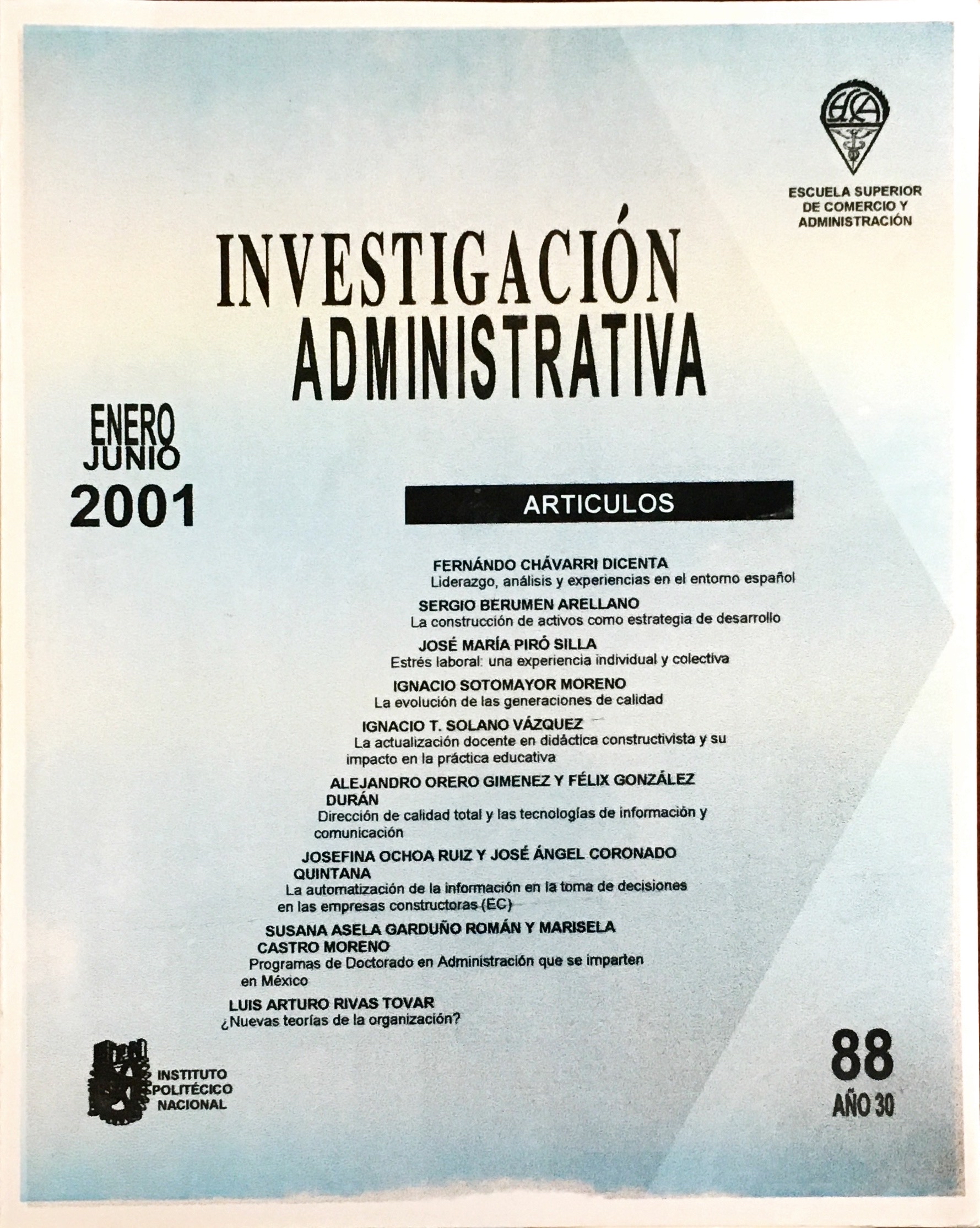Automation of information in decision-making in construction companies (EC)
Main Article Content
Abstract
The present work studies the influence of information automation in the effectiveness of decision-making with in the environment of construction companies. It also analyse the relationships among the information automation, environmental uncertainty, effectiveness of decision-making and the size of the company. Firstly, it was carried out a documental investigation; later a field work in Hermosillo. Son., Méx. As a result it was concluded that the effectiveness of decision-making is fundamentally influenced, in a negative form, by the environmental uncertainty. It was also concluded that the use of the automation, especially in construction and communication systems, reduce the environmental uncertainty and increase the effectiveness of decision-making. Finally it was found that the size of the company is negatively related with the environmental uncertainty and positively with the information automation and the effectiveness in decision-making.
Article Details

This work is licensed under a Creative Commons Attribution-NonCommercial 4.0 International License.
References
Chou, T., Dyson, R. y Powell, P. (1998). "An empirical study of the impact of information technology intensity in strategic investment decisions". Technology Analysis & Strategic Management Abingdon. 10(3): 325-339.
Church, A. y Waclawski, J. (1999). "Influence behaviors and managerial effectiveness in lateral relations". Human Resource Development Quarterly. San Francisco. 10(1): 3-34.
CMIC Cámara Mexicana de la Industria de la Construcción, (1998). Desarrollo Tecnológico, Fundación de la Industria de la Construcción para el Desarrollo Tecnológico y de la Productividad, Filosofía de la Fundación. http://www.cmic.org/tecnologico/FIC/filosofun.htm.
Collins, P., Ryan, Lori V. y Matusik, S. (1999). "Programable Automation and the Locus of Decision-Making Power". Journal of Management. 25(1): 29-53.
Dean, T., Brown, R. y Bamford C. (1998). "Differences in Large and Small Firm Responses to Environmental Context: Strategic Implications from a Comparative Analysis of Business Formations". Strategic Management Journal 19(8): 709-728.
Deluga, R. (1998). "Leader-Member Exchange Quality and Effectiveness Ratings Group & Organization Management". Thousand Oaks. 23(2): 189-216.
El Louadi, M. (1998). "The relationship among organization structure, information technology and information processing in small Canadian firms". Revue Canadienne des Sciences de ¡'Administration. Montreal 5(2): ISO- 199.
Francalanci, C. y Galal, H. (1998). "Information technology and worker composition: Determinants of productivity in the life insurance industry". Management Information Systems Quarterly. Minneapolis. 22(2): 227-241.
Gaimon, C. (1997). "Planning Information Technology- Knowledge Worker Systems". Management Science 43(9): 1308-1328.
lacovou, C., Benbasat, I. y Dexter, A. (1995). "Electronic Data Interchange and Small Organizations: Adoption and Impact of Technology". Management Information Systems Quarterly 19(4): 465-485.
Khatri, N. y D'Netto, B. (1997). "Perceived uncertainty and performance: The causal direction". Journal of Applied Management Studies. Abingdon. 6(2): 219-232.
Koontz, H. y Weihrich, H. (1998). Management Information Systems Quarterly. McGraw Hill, México, D.F. 11a. Edición.
Koop, D. y Litschert, R. (1980). "A Buffering Response in Light of Variation in Core Technology, Perceived Environmental Uncertainty, and Size". Academy of Management Journal 23(2): 252-266.
Lenard, M., Madey, G. y Alam, P. (1998). "The Design and Validation of a Hybrid Information System for the Auditor’s Going Concern Decision”. Journal of Management Information Systems, 14(4):219-237.
Martinsons, M. y Chong, P. (1999). "The influence of human factors and specialist involvement on information systems success". Human Relations New York. 52(1): 123-152.
Matthews, C. y Scott, S. (1995). "Uncertainty and Planning in Small and Entrepreneurial Firms: An Empirical Assessment". Journal of Small Business Management. 33(4): 34-52.
Miller, D. y Friesen, P. (1983). "Strategy-Making and Environment: The Third Link". Strategic Management Journal. 4(3): 221-235.
Milliken, F. (1987). "Three Types of Uncertainty about the Environment: State. Effect. and Response
Uncertainty". Academic of Management Review 12: 133-143.
Motiwalla, L. y Fairfield-Sonn. J. (1998). "Measuring the impact of expert systems". The Journal of Business and Economic Studies Fairfield. 4(2): 1-17.
Pinsonneault, A. y Kraemer, K. (1997) .""Middle Management Downsizing: An Empirical Invewstigation of the impact of Information Technology”. Management Science. 43(5): 659-679.
Pinsonneault, A. y Rivard, S. (1998). "Information technology and the nature of managerial work: From the productivity paradox to the Icarus paradox?". Management Information Systems Quarterly Minneapolis. 22(3): 278- 311.
Post, J. y Kagan, A. (1996). “Evaluating Uses of Information Technology in Health Care Administration”. Journal of Applied Business Research. 14(2): 1-10.
Ragowsky. A., Ahituv, N.; y Neumann, S. (1996). "Identifying the value and importance of an information system application”. Information and Management. 31(2): 89- 102.
Rai, A. y Bajwa, D. (1997). ‘‘An Empirical Investigation into Factors Relating to the Adoption of Executive Information Systems: An Analysis of EIS for Collaboration and Decision Support”. Decision Sciences. 28(4): 939-973.

